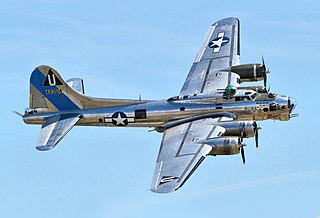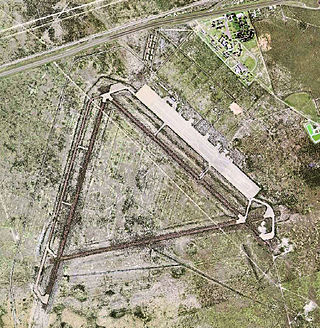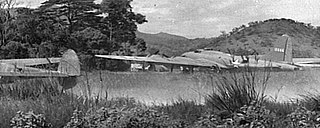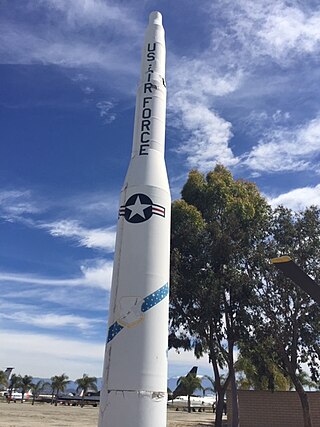
The Boeing B-17 Flying Fortress is an American four-engined heavy bomber aircraft developed in the 1930s for the United States Army Air Corps (USAAC). A fast and high-flying bomber, the B-17 was used primarily in the European Theater of Operations and dropped more bombs than any other aircraft during World War II. It is the third-most produced bomber of all time, behind the American four-engined Consolidated B-24 Liberator and the German multirole, twin-engined Junkers Ju 88. The B-17 was also employed in transport, anti-submarine warfare, and search and rescue roles.

Pyote Air Force Base was a World War II United States Army Air Forces training airbase. It was on 2,745 acres (1,111 ha) a mile from the town of Pyote, Texas, on U.S. Highway 80, 20 miles west of Monahans,` 230 miles (370 km) east of El Paso.

The Boeing C-108 Flying Fortress was an American transport aircraft used during World War II. Four were converted from B-17 Flying Fortress heavy bombers.

Royal Air Force Polebrook or more simply RAF Polebrook is a former Royal Air Force station located 3.5 miles (5.6 km) east-south-east of Oundle, at Polebrook, Northamptonshire, England. The airfield was built on Rothschild estate land starting in August 1940.

Liberty Belle was a popular name for United States Army Air Forces (USAAF) aircraft during World War II; over two dozen known individual Boeing B-17 Flying Fortresses and Consolidated B-24 Liberators used the name.

The Memphis Belle is a Boeing B-17F Flying Fortress used during the Second World War that inspired the making of two motion pictures: a 1944 documentary film, Memphis Belle: A Story of a Flying Fortress and the 1990 Hollywood feature film, Memphis Belle. It was one of the first United States Army Air Forces (USAAF) B-17 heavy bombers to complete 25 combat missions, after which the aircrew returned with the bomber to the United States to sell war bonds.

The Pink Lady is the nickname of a B-17G Flying Fortress bomber, serial number 44-8846, which flew several missions for the United States Army Air Forces (USAAF) over Nazi Germany near the end of World War II. The plane is now on static display in Cerny, Essonne, France.

Piccadilly Lilly II is a B-17 Flying Fortress currently on display at the Planes of Fame air museum in Chino, California. Built in 1945 as a B-17G and assigned serial number 44-83684, this plane was possibly the last aircraft assigned to the Eighth Air Force / 447th Bomb Group, but perhaps not delivered. It was the last active B-17 in the United States Air Force, and retired in 1959 after nine years as a DB-17P drone director. Following its military career, the plane appeared in various television shows and movies.

Nine-O-Nine was a Boeing B-17G-30-BO Flying Fortress heavy bomber, of the 323d Bombardment Squadron, 91st Bombardment Group, that completed 140 combat missions during World War II, believed to be the Eighth Air Force record for most missions without loss to the crews that flew her. A different B-17G, painted to mimic the Nine-O-Nine, crashed at Bradley International Airport in Windsor Locks, Connecticut, in October 2019.

Sally B is the name of an airworthy 1945-built Boeing B-17G Flying Fortress. At 79 years old, she is the only airworthy B-17 based in Europe, as well as one of three B-17s preserved in the United Kingdom. The aircraft is presently based at the Imperial War Museum Duxford, in eastern England. Sally B flies at airshows in the UK and across Europe as well as serving as an airborne memorial to the United States Army Air Forces airmen who lost their lives in the European theatre during World War II.

Shoo Shoo Shoo Baby, originally Shoo Shoo Baby, is a Boeing B-17 Flying Fortress in World War II, preserved and currently awaiting reassembly at the Smithsonian's National Air and Space Museum. A B-17G-35-BO, serial number 42-32076, and manufactured by Boeing, it was named by her crew for a song of the same name made popular by The Andrews Sisters, the favorite song of its crew chief T/Sgt. Hank Cordes. Photographs of the bomber indicate that a third "Shoo" was added to the name at some point in May 1944 when the original aircraft commander completed his tour of duty and was replaced by another pilot.

Old 666 was a Boeing B-17E Flying Fortress heavy bomber, serial number 41-2666, assigned to the United States Army Air Forces (USAAF) 19th and 43rd Bombardment Groups in 1942–1943. It is notable for being the aircraft piloted by Lt. Jay Zeamer Jr. on the 16 June 1943 mission which earned him and 2nd Lt. Joseph Sarnoski each a Medal of Honor, and all other members of the aircrew the Distinguished Service Cross.

Aluminum Overcast, B-17G-105-VE, s/n 44-85740, civil registration N5017N, as of August 2024 Aluminum Overcast is not flying. It is in the Eagle Hanger at the Experimental Aircraft Museum in Oshkosh,WI. It is awaiting wing spar repair. Boeing B-17 Flying Fortresses of the 46 complete surviving airframes in existence. It never saw combat, and it escaped the fate of many aircraft that were scrapped after World War II. It is owned by the Experimental Aircraft Association (EAA), and, as of 2022, it is still touring the United States and Canada offering flight experiences.

Texas Raiders was an American Boeing B-17 Flying Fortress, a B-17G-95-DL built by Douglas Long Beach. In 1967, it was purchased by the Commemorative Air Force's Gulf Coast Wing "Texas Raiders" group, which maintained and flew the aircraft out of Conroe-North Houston Regional Airport in Conroe, Texas. The aircraft was destroyed on November 12, 2022, by a mid-air collision with a P-63 Kingcobra at an air show at Dallas Executive Airport, Texas, that killed all five occupants and the P-63 pilot.

The 510th Missile Squadron is an inactive United States Air Force unit. It was last assigned to the 351st Operations Group at Whiteman Air Force Base, Missouri. The squadron was equipped with the LGM-30F Minuteman II Intercontinental ballistic missile with a mission of nuclear deterrence. With the end of the Cold War, the 510th was inactivated on 15 November 1993.

The 3205th Drone Group is a discontinued United States Air Force unit that operated obsolete aircraft during the 1950s as radio-controlled aerial targets for various tests. It was the primary post-World War II operator of surplus Boeing B-17G Flying Fortress aircraft, and also operated Lockheed F-80 Shooting Star and a few Boeing RB-47 Stratojet bombers that were converted into drone aircraft during the early years of the Cold War. It was last active with the Air Proving Ground Center, based at Eglin Air Force Base, Florida, where it was discontinued on 1 February 1961.

Boeing B-17G Flying Fortress No.44-83690 is a B-17 Flying Fortress heavy bomber currently undergoing restoration at the Museum of Aviation near Robins Air Force Base in Georgia. It was built as a B-17G-95-DL by the Douglas Aircraft Company and delivered for use on May 9, 1945. It was flown to Grissom Air Force Base for display as a museum piece in 1961. The plane was listed on the National Register of Historic Places in 1993. It was moved to the Museum of Aviation in August 2015.























